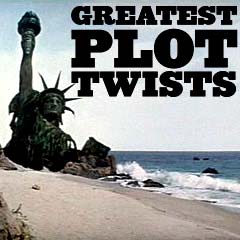
|
|
|
||||||||||||||||||||||||||||||

|
The Jacket (2005)
Director John Maybury's sci-fi time-travel thriller was similar in plot to La Jetee (1962, Fr.) and Jacob's Ladder (1990) - a circular plot that brought the time-traveling protagonist back and forth numerous times, enough to provide knowledge that could alter the future. [Note: It was entirely possible that the protagonist had died from a traumatic and mysterious head injury - and everything that he experienced in the film afterwards was just an hallucination.] The tagline was: TERROR HAS A NEW NAME. In the opening, a Persian Gulf War veteran (unidentified) in Iraq in 1991 was shot by a young Iraqi boy at close-range during an ambush. The soldier spoke (in voice-over):
As the dead man was tagged in a medical tent, he was identified as Marine Sgt. Jack Starks (Adrien Brody) -- "Starks, Jack. Born in Vermont. Hasn't got a family listed. Naval hospital will take care of it." But then, he miraculously opened his eyes ("This soldier's alive. This man just blinked") and a Code Blue was called. He had luckily survived the bullet wound to the back of his head - importantly, he was not specifically told the circumstances of his death. As a result of his severe head injury, he suffered from "retrograde amnesia, acute psychological suppression" - and was recommended for the Bronze Star.
12 months later (in 1992), he appeared in his home-state of Vermont, where he was seen walking down a snowy road. He came upon a young girl named Jackie Price (Laura Marano), the daughter of drunken mother Jean (Kelly Lynch), whose pick-up truck was stalled by the side of the deserted road. When Jackie asked about his dog-tags from the war (with his name and date of birth), he gave them to her, explaining their purpose: "In case I get lost or can't remember who I am" -- an important plot element. Once Jean revived from her alcoholic and drugged state, she was repulsed by Jack, even though Jackie kept repeating that he had fixed their car, and she drove off with her daughter. Later, after Jack left them and continued to hitch-hike toward Canada, he was picked up by another driver, but soon after, their car was stopped by a cop for driving too slow. Then without knowing what happened, the scene changed - the policeman was dead, Starks was wounded, and he was falsely accused of the murder of Officer Harrison (who Starks claimed was shot three times by the driver, with the cop's own gun). When questioned about everything, authorities discovered that there was no last name, no physical presence, and no residence or any other records for Jean and Jackie - his sole recollections of the day. Believing he was suffering from Gulf War syndrome with "a damaged mind," the court found him not guilty by reason of insanity. Even Jack's lawyer stated: "My client thinks he already died once." Still in the year 1992, Jack was committed to Alpine Grove Psychiatric Hospital - an institution for the criminally-insane. One night, Starks was injected with an experimental hallucinatory drug and placed in a tight body-length strait-jacket within a basement morgue drawer for three hours, causing him to have frightening, surrealistic recollections. The therapy treatment was recommended by the creepy and deranged Dr. Thomas Becker (Kris Kristofferson) who was in charge of the hospital. Jack also became acquainted with another well-meaning therapist, Dr. Beth Lorenson (Jennifer Jason Leigh).
While being examined after his first drawer experience, Starks appeared to be behaving himself and was cooperative, but then he aggressively attacked Dr. Becker and injured his cheek. As punishment, Starks was again subjected to being strapped down and wheeled into the claustrophobic drawer, without being tranquilized. Dr. Becker rationalized that the drugs he was using would reset Starks' "violent proclivities - peel away some layers of hate." He added that he wasn't worried about the lack of constant monitoring: "You can't break something that's already broken." Starks was heard whimpering: "I don't belong here. I can't breathe in here." The repeated use of the drug and the apparatus of the mortuary drawer caused Jack to have rapidly-edited visions of the future. He experienced time travel transport to the future for short periods of time, before he would flash-back and return to the past (or present-day). During another psychotic time-travel trip forward, his first major trip, Starks was taken 15 years into the future to the year 2007 on Christmas Eve, where he met up again, in St. Albans, VT, with an older, grown-up version of Jackie Price (Keira Knightley as adult) - now a dark-eyed, sickly, chain-smoking waitress employed at Baillie's Motel and Diner. After work when Jackie noticed that a man at a taxi stand was homeless and unprepared for the cold, she picked him up and took him to her place, but had no other option but to have him sleep on her couch. She warned: "There's nothin' to steal, but don't be a jerk and take something anyway." She also cautioned as she left to take a bath that she didn't want to get to know him or his name: "I don't wanna meet you. I may wanna help you tonight, but I don't wanna know you, really." By chance, he made two remarkable discoveries in her living room. Jack happened to see his dog-tags given to her years earlier in 1992, and a picture of the young girl with her now deceased mother.
Jackie told him that her mother had died: "She passed out with a cigarette and burned to death a long time ago." As a result of her mother's death, Jackie's life had gone into decline and isolation. She was a chain-smoker, a drinker, lonely, sad and depressed, and sickly. Disbelieving him and upset for snooping around, she demanded that he leave immediately. She also insisted that his recollections about meeting them, giving her his dog-tags and his claim that he was Starks were all very inaccurate. Somehow, she knew about Starks' death on January 1, 1993: "...Jack Starks is dead....He's dead. His body was found New Year's Day, 1993, Alpine Grove.... I don't care who or where you think you are, you're not Jack Starks." He pleaded: "Don't you remember me?" He desperately tried to have her remember their first meeting on the roadside when she was a child: "I met you and your mother, and there was no one around for miles. I couldn't have known that from a pair of dog tags you had lying around." But she remained upset and screamed for him to get out. He reawoke in the mortuary drawer and jacket the next morning, dehydrated after having been left in all night. After Dr. Beth Lorenson realized that Dr. Becker had prescribed antipsychotics for Starks, including Loxadol and Ativan, she questioned his judgment and was against his experimental therapeutic techniques: "I don't know what you're trying to do, but he's not a lab animal. You can't reprogram them, no matter what cocktail of drugs.." Due to his second time-travel trip, the one that took him into the future (late 2007), Jack knew that he had only about a week until his death - from Christmas Day until News Years Day - it was now a race against time and he realized that he had to get back in the drawer. Starks instigated an uproar in a group therapy meeting to cause further punishment. Another trip from 1992 to the future year of 2007 added more helpful detail. Jack relived the shooting of the policeman that was blamed on him and sent him to the asylum. The cop was shot dead by the driver who had picked him up, and Jack was also accidentally hit by a stray bullet. He met up with Jackie again at the diner, who unlike his previous trip a few days earlier was now very cooperative and intrigued and had done some research. He learned from her that he had died from a head wound: "Jack Starks died from a wound to the head, January 1st, 1993." Dr. Becker, whose preferred and advocated form of therapy was the jacket in the drawer - ("to create a womb-like environment for his patients") - was a previously-banned behavioral modification technique in the 1970s. With Jackie accompanying him to the hospital, Jack posed as his own nephew to inquire about his uncle's "blunt trauma" death (his own death!) at the current Alpine Grove Institution. They met with the still-employed, older Dr. Lorenson, who remembered Stark as her "most memorable patient" who helped influence her thinking about extreme therapeutic methods with a young boy patient. She claimed Starks died from "a head trauma." In the film's spookiest sequence, Jack took Jackie to the hospital's basement, a restricted area, where he showed her his morgue drawer (where incidentally, he was - although years earlier!). They also visited Jack's gravesite where he had been buried - proving he died on Jan 1, 1993. Jack also made love to Jackie before departing, when he told her: "I'm running out of time," as she insisted: "I don't care. You have to come back....Come back to me, Jack." [Did she know of his time travels and that he only had a few days left?] Jack suddenly disappeared from her arms when he was abruptly removed from the drawer. Back in late 1992, Jack was able to convince Dr. Lorenson of his credible story that possibly, he wasn't delusional and had spoken to her in the year 2007 during his time-travels: ("I know somewhere inside of you, you have to believe that what I'm saying is true"). While on another time journey, Jackie filled Jack in with more details about Dr. Lorenson's work. She had been treating a boy named Babak and had used a mild form of electroshock therapy which disrupted his seizures and helped to reset his brain. The two also located the now-retired Dr. Becker in town, who denied killing Jack Starks in the hospital and believed the 'drawer treatment' was a justified and useful technique for many of his patients. He could not provide any helpful information other than: "We're all dead, Jack." Jack feared Becker would stop treatments and it would be his "last time" visiting Jackie in 2007. Jack was pulled from the drawer by Becker, returning him to 1992, where he accused Becker of mistreating his patients and being haunted in his latter years by memories of his faulty methods: "All of us. We all stay with you. We haunt you, haunt you." Back in 1992, Dr. Lorenson was convinced to go ahead with Jack's suggested ECT (electro-convulsive therapy) treatments for the boy that he knew about from the future, and they turned out to be successful: ("You're okay, you're okay"). As a result and in exchange, she agreed to smuggle Jack out of the asylum and drive him to the Price home. On the day of his predicted death, January 1, 1993, Jack personally delivered a letter to Jean Price's house (while Dr. Lorenson waited outside), once more meeting young Jackie who recognized him as the guy who fixed the truck. After leaving the house and being driven back to the psychiatric hospital, Jack suffered the predicted serious "blunt trauma" head injury when he accidentally slipped and cracked his head on the icy concrete driveway.
Before he died, Jack was rushed into the jacket and drawer, while his voice-over described recollections about being regarded as dead and crazy, but about how he had been given a second chance: "I was 27 years old the first time I died. I remember there was white everywhere. There was war, and I felt alive. But, really, I was dead. Sometimes I think we live through things only to be able to say that it happened. That it wasn't to someone else, it was to me. Sometimes we live to beat the odds. I'm not crazy, even though they thought I was. I live in the same world as everyone else. I just saw more of it, as I'm sure you have. They'll find my body tomorrow. You can check it out if you don't believe me." It was revealed that the voice-over consisted of the contents of Jack's letter written to Jean, Jackie's mother. He described his knowledge of future events (the death of Jean due to a smoking accident, told to him by Jackie). He gave her a warning about how to prevent future tragedy for her young daughter:
In the conclusion, Jack experienced his last time travel trip to the future (the year 2007) to bring him to Jackie. When he arrived, their initial meeting from 2007 was reprised - as before, she didn't know him. Driving a new VW car and looking healthier, Jackie picked him up awaiting a ride, after she noticed his bruised head with a "nasty cut." He told her: "I slipped, but I'm alive." She offered to drive him to the hospital, since she worked there as a nurse. Immediately, he knew that his letter had altered the future and changed her life for the better. On the drive, Jackie received a friendly phone call from her mother - who was very much alive, and in a better, more functional relationship with her. The screen faded to bright white as Jack and Jackie talked in the car:
Her response revealed that the link to the "previous" future of 2007 wasn't lost. The lyrics of Iggy Pop's closing rendition of We Have All the Time in the World answered her question - "It's never too late." |
 The Fatal Gun Shot 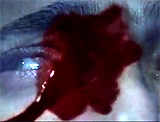 Sgt. Jack Starks (Adrien Brody): "I was 27 years old the first time I died." 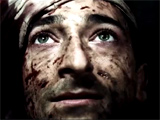 Naval Hospital: "This man just blinked."  The Court - Believing Jack Was Insane, Jack Was Committed to a Psychiatric Hospital 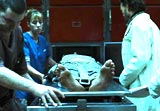 Jack Drugged, Strapped Down and In a Strait-Jacket, and Placed In Mortuary Drawer 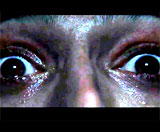 Jack's Wide-Eyed Reaction to His Mental, Psychotic Excursions During Treatment 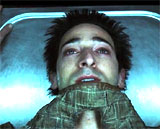 After First Use of the Drawer, Jack Was Removed After 3 Hours 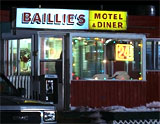 Time Travel Into the Future - to Baillie's Motel and Diner in Vermont 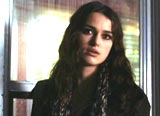 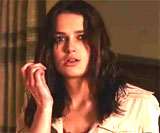 Diner Waitress - Older Jackie Price (Keira Knightley as Adult) 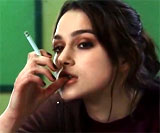 Jackie - Helpful to Jack In Finding Out Information For Him 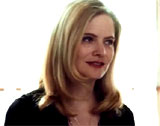 Dr. Sorenson in the Year 2007 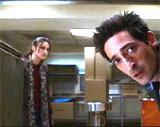 In 2007, Jack Looked into the Drawer Where He Was Often Punished in 1992 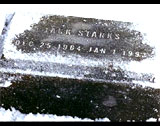 Jack's Gravestone - Showing His Date of Death Jan 1, 1993 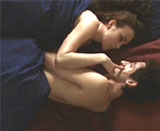 After Making Love to Jackie: "Come back to me, Jack" 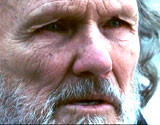 Becker in 2007: "We're all dead, Jack" 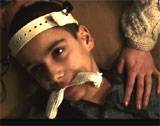 Successful ECT Therapy For Dr. Lorenson's Young Patient Babak 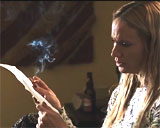 Jack's Voice-Over - His Letter, Warning Jean About Her and Jackie's Future 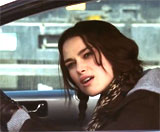 Jackie Picking up Jack 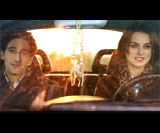 Jack's Final Return to the Year 2007 - Reunited with Jackie - Both of Their Futures Had Been Altered |
||||||||||||||||||||||||||||
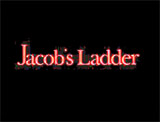
|
Jacob's Ladder (1990)
Director Adrian Lyne's psychological thriller had a very misleading tagline:
In the prologue set in 1971, Vietnam vet soldier Jacob Singer (Tim Robbins) suffered a serious bayonet wound to the stomach, and was helicoptered out of the fighting zone to an army hospital. The film led one to believe he survived, but in reality, he died in combat on an operating table (revealed in the final scene). Singer's horrifying, hallucinatory visions of horned creatures and demons were the fantasies and dreams of a dying (or dead) man (experiencing death-bed visions) who couldn't accept his death and was unwilling to let go. Throughout the film, there were foreshadowings of his death:
At an erotic disco dance (to the tune of James Brown's Ma Thang (Sex Machine)) on a crowded dance floor with his temptress Latina girlfriend Jezzie (Elizabeth Pena), Jacob saw a snake-like devil with a scaly reptilian tail curled around her and then a horn abruptly ripped open her mouth. His guardian angel/chiropractor Louis (Danny Aiello) counseled him about hell being like purgatory:
Before accepting his own death, Jacob needed to be reconciled with the fact of the death of his young 6 year-old son Gabriel (uncredited Macauley Culkin) while he was still in Vietnam, when he remembered (or imagined) Gabe's death by an automobile when the young boy was picking up baseball cards he had dropped in the middle of the street while walking his bicycle. Jacob also had a secret rendezvous with 'hippie chemist' Michael Newman (Matt Craven) who told him that his battalion had been secretly given a dose in their C-rations of an experimental psycho-reactive drug (code-named 'ladder'), to counteract the effects of combat-induced post-traumatic stress, by causing soldiers to become more aggressive in combat. Its negative side effects were intense hallucinations and in some instances, soldiers would attack and kill each other. It was hinted that Jacob's war injury was from 'friendly fire.' Although there may have been a government conspiracy, Jacob's hallucinations upon his return to NYC were not caused by the drug, or battle stress, but because he wasn't freeing his soul. In the next-to-final scene (in his old apartment bathed in golden light), Jacob finally accepted his own death. In the climax, Jacob spotted his dead son Gabe, who was playing with a red music box (playing "Sonny Boy") on the stairs - the boy looked up and greeted him with: "Hi Dad!" As they hugged, Gabe reassured his father: "It's OK" - followed by Gabe telling him: "Come on, let's go up" - meaning their ascension up the staircase into the golden light. Jacob's death on an operating table in Vietnam was then revealed, as an army doctor stated:
The final screen stated the alleged combat use of an hallucinogen called 3-quinuclidinyl benzilate:
|
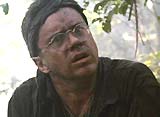 Vietnam Vet Jacob Singer (Tim Robbins) 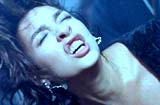  Jezzie (Elizabeth Pena)  Hallucinations 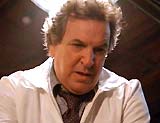 Louis (Danny Aiello)  6 year-old son Gabriel (Macauley Culkin) - Hit by Automobile 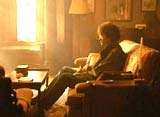 Jacob Accepting His Death 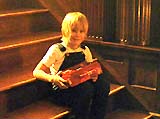 Dead Son Gabe On Stairs With Red Music Box 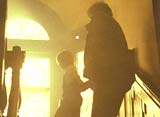 Up the Staircase "Ladder" Into the Golden Light 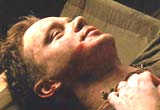 Jacob's Death on Operating Table |
||||||||||||||||||||||||||||
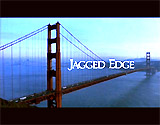
|
Jagged Edge (1985)
The surprise, contrived twist ending of this early Joe Eszterhas-penned courtroom thriller with many surprises finally revealed the truth -- that accused suspect and newspaper magnate Jack Forrester (Jeff Bridges) was guilty of a double homicide the entire time (in the opening sequence, he killed his San Francisco wife-wealthy socialite/heiress Page Forrester (Maria Mayenzet) and the house maid in their remote beach house), although he was found innocent. He had inflicted a head wound upon himself, to detract suspicion. Jack's motive, argued by prosecutor Thomas Krasny (Peter Coyote), was to inherit his wife's entire SF Times publishing empire fortune. He was engaged in an unprofessional affair with divorced, retired criminal law attorney Teddy Barnes (Glenn Close), a divorced mother with two children. When she made the startling discovery in a closet of his damning 1942 Corona typewriter (with a unique typeface including elevated 't's', that were found in all of the anonymous letters), she told Forrester. As a result, the killer attempted to eliminate her. In the nail-biting conclusion, she heard the breaking of glass at a back door, and prepared herself for an attack in her upstairs bedroom late at night. The intruder was dressed with a ski mask and black leather clothing and was carrying a prominent murder weapon - a jagged edged or serrated hunting knife. When he approached the bed, and removed rope from his pocket to create a noose, she implored: "I need to see your face, Jack." As she added, "I could have loved you...", he grabbed at her, and she responded by shooting him several times with a concealed gun. As he staggered and fell to the floor, she shot two more times. When the dead, dark figure on the floor was unmasked by detective Sam Ransom (Robert Loggia), it was revealed that it was Jack who was the attacker. A tear came to Teddy's eye. Ransom delivered the film's last line to her to reassure her: "F--k him, he was trash." The last image, before the credits, was a close-up of the jagged edged knife in the killer's hand.
Questions about the twisting and unpredictable plot included:
|
 Teddy Barnes (Glenn Close) 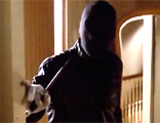 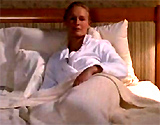 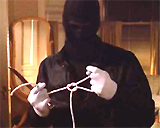 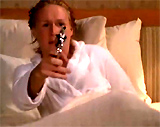 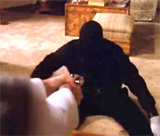 Awaiting the Killer and Shooting Him 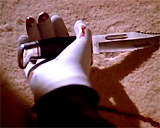 Close-Up of Jagged Edged Knife |
||||||||||||||||||||||||||||


|
Kill Bill, Vol. 1 (2003)
Writer/director Quentin Tarantino's blood-soaked, very violent action and grindhouse film (a revenge fantasy), contained numerous pop cultural references and stylized violence - it was another cinematic homage to the genres he loved most: kung-fu and martial arts (chopsocky) films, crime dramas, Japanese anime, B-movies, blaxploitation, Hong Kong action films, samurai sword epics and 'spaghetti' westerns. The film's main plot was revenge of an assassinatrix (or hit-woman) named the "Bride" (Uma Thurman) (aka Black Mamba), after her presumed 'death' on her El Paso, Texas "dress rehearsal" wedding day. She had been attacked in the chapel by four members of the DiVAS (the Deadly Viper Assassination Squad) - an elite group that she used to belong to, led by her unseen boss Bill (David Carradine). In the film's opening sequence, set right after the massacre in the chapel, Bill wiped the Bride's bloody face with his monogrammed handkerchief, as he told her:
As he cocked his pistol, she replied: "Bill, it's your baby," but he put a bullet into her head anyway. It appeared that everyone, including her unborn child, were murdered as well as members of the bridal party. However, the Bride survived the attack although she was comatose for four years (when she awoke from her coma, she cried out, "My baby, my baby!"). She created a Death Hit List of five that she would target: the four DiVAS, and finally Bill. In the conclusion of the film, the Bride tracked Bill to the Mexican countryside, to a hotel hacienda where she met for the first time with her 4 year-old child, named B.B. (Perla Haney-Jardine). B.B. obviously loved her father, who had told her that Mommy was asleep, but that one day she'd wake up and come back to her (B.B. confirmed this: "I waited a long time for you to wake up, Mommy"). They all played at being a family for awhile and Bill made a sandwich for the girl. When Bill shot the Bride with truth serum, she was interrogated by him. It was revealed that the Bride (aka Arlene Machiavelli - the fake name on her marriage certificate) was Bill's former lover. He had become disturbed by her secret pregnancy, her move to El Paso, and her planned wedding to Tommy Plympton (Christopher Allen Nelson), a used record store dealer in El Paso. The Bride, real-named Beatrix Kiddo, tried to escape the assassination-business (and Bill's Deadly Vipers) when she found out she was pregnant (she wanted to keep the baby a secret so that Bill wouldn't claim it):
When the Bride disappeared and settled in El Paso, Texas, Bill became jealously enraged - he ordered her assassination and also pulled the trigger on her head, and then unbeknownst to her, cut out her unborn child (in utero) and lovingly raised the daughter himself. [The last line of Vol. 1 provided this hint from Bill: "Is she aware her daughter is still alive?"] Beatrix ultimately sought revenge against the estranged Bill, claiming that she had "unfinished business with him." To kill him, she used "the five point palm-exploding heart technique" taught to her by martial arts master Pai Mei (Gordon Liu), and he died after taking five steps on his back lawn. Then, she departed with B.B., and the next morning, felt conflicting emotions (both grief and laughter) over the death of Bill, as she lay on a motel bathroom floor while hugging a stuffed animal ("Thank you, Thank you"). She then hugged her child as they watched Saturday morning cartoons in the adjoining bedroom together ("THE LIONESS HAS REJOINED HER CUB AND ALL IS RIGHT IN THE JUNGLE"). |
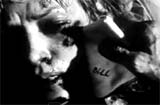 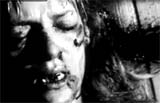 'Killing" of The Bride (Beatrix Kiddo) - Massacre in Chapel  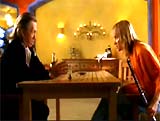 The Bride Seeking Revenge on Bill (David Carradine) 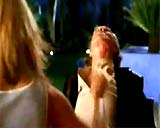 Disabling Bill: "The Five Point Palm-Exploding Heart Technique"  Hugging Stuffed Animal 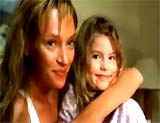 The Bride With Daughter B.B. |
||||||||||||||||||||||||||||

|
Kill List (2011, UK)
Co-scripter and director Ben Wheatley's low-budget, weird psychological, folk-horror film concluded with an unexpected, shocking sequence - a complete descent into hell. Much of the decidedly non-literal film was tied together by the image of a strange pagan symbol (the film's motif - (it bookended the film), described as a triangular-shaped, pointed teepee in the crosshairs of a gun. It appeared throughout the film as markings - on the back of a mirror, on a file folder, and other locales. The film's thematic content was partially similar to Race With the Devil (1975), and indirectly related to The Wicker Man (1973). The film's tagline forecast violence:
Two ex-soldiers and best friends, after a disastrous, botched hit-job mission in Kiev, were pressured into again becoming contract killers due to being cash-strapped:
The unemployed Jay lived in a suburban area of England, married and in a turbulent relationship with his younger blonde Ukranian wife, Shel (Swedish actress MyAnna Buring), and with their 10 year-old son Sam (Harry Simpson). They often argued about Jay's inability to secure a good paying job and were stressed out about their financial issues. During a chaotic dinner party sequence at Jay's place (that foreshadowed future violence), attended by partner-in-crime Gal and his girlfriend Fiona, Jay reacted by pulling out the dinner tablecloth, upturning the table's contents, and ended up in a shouting fight with Shel. Fiona was seen in the upstairs bathroom where she removed a mirror from the wall and with a sharp knife-point, she cut deep marks (the strange symbol yet to be explained) on its backing - it was in the shape of a cross with a triangle sitting on the horizontal cross-bar. Then she took bloodied tissue from Jay's previous, early morning shave and put them in her bra.
Jay was set up to accept a 'job' from his old Army buddy Gal to engage in a series of three contract killings for a blond-haired Client (Struan Rodger). During the meeting to work out the details of their new contract (three targets in a week's work with a large payout), Jay's hand was suddenly grabbed and cut with a sharp knife, in order to execute the paper properly signed in blood - a blood oath. (Did it signify a deal with the devil?") Note that it was strange that Gal was not required to have his hand slit. The hits were advertised with three large, B/W pretentious titles. [Note: Oddly enough, each of the victims thanked Jay as he killed them - they were honored to be sacrificed by him.]
[Note: Eventually, it was revealed that the victims belonged to a mysterious ritualistic pagan cult. The Librarian's files and folders, never fully seen, were possibly research into the Kiev disaster, and provided some evidence that Jay's background might have been investigated while being considered to be the cult's new leader.] Under duress and pressure to execute the third kill on the list (their 3rd contract-hit - the M.P.), including threats to Jay's family, Jay took his wife Shel and son Sam to their remote family cottage for safety and protection. Meanwhile, Gal and Jay camped out in the woods to survey their next target's mansion. They heard drumming noises and watched a group of men and women marching through the forest area with fire torches. Some were naked and some wore black robes. Many had masks made out of straw. A nude woman had a crown of thorns pulled down as a blindfold over her bleeding eyes, as she stood next to a naked man. One of the females (wearing a blue dress) stood on a tree-stump stool beneath a tent-like gallows structure (similar to the film's motif) - she then placed a noose around her neck, and hung herself to death, as the members around her applauded her mortal sacrifice. Jay retaliated by opening fire on the cult. He shot the leader of the ceremony (the M.P.?) in the heart, who voluntarily offered himself (with arms outstretched) to be killed. Jay then fled with Gal by escaping through a network of sewage outlet tunnels. During their flight, Gal was stabbed and disemboweled in the stomach by one of the cultists and was bleeding out, and Jay was forced to mercy-kill Gal. Jay left the tunnels and sought refuge with his family members in the cottage. During a siege, Jay was knocked unconscious. He awoke after being captured and returned to the forest area where the cultists were first seen, and was within a circle of figures (some with straw or wicker masks) in the darkness of the woods. In the film's dialogue-less ending, Jay was stripped to the waist and forced to fight to the death against his final masked "Hunchback" opponent. [Note: This scene was foreshadowed earlier when Jay fought against Shel and Sam in the garden with toy swords.] After succeeding in stabbing his opponent to death with a knife, Jay uncovered the figure's white sheet and discovered the Hunchback was his wife Shel with Sam strapped to her back. She laughed (ironically and mockingly), with blood dripping out of her mouth, as she died. [Note: Was Shel also one of the cult members who was 'happy' and pleased to be killed by Jay?]
The various cultists, including Fiona, a Doctor, and his Client who had removed their masks, applauded the stunned, remorse-less and emotionally-dead Jay, and he was rewarded with a crown by the Client. Jay had been chosen as the new leader for the death-worshipping cult after proving his worth - and possibly would perform the nude couple's wedding ceremony? |
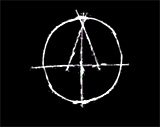 Strange Symbol - The Symbol of the Pagan Cult 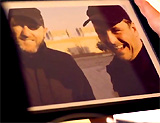 (l to r) Picture of Gal and Jay  Jay's Wife Shel (MyAnna Buring)  Gal's Girlfriend Fiona (Emma Fryer)  The Client (Struan Rodger) Hiring Two Hit-Men: Jay and Gal  Jay's Blood-Oath Contract 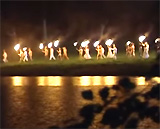 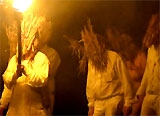 The Cultists Marching Through Woods With Torches 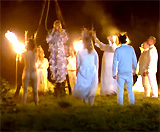 Female's Sacrificial Hanging During Ceremony  THE MP (James Nickerson) - a member of Parliament 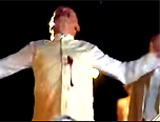 Jay's Murder of Cult Leader - was he the M.P.? 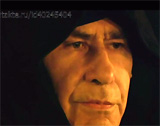 One of the Cultists 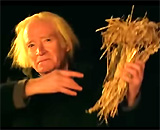 Ending Revelation: The Client - One of the Cult Members 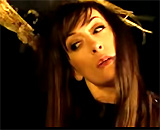 Fiona - One of the Cult Members 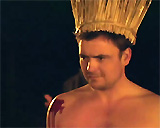 Jay Crowned by the Cultists as Their New Leader |
||||||||||||||||||||||||||||
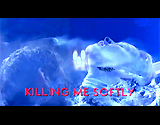
|
Killing Me Softly (2002)
Chinese filmmaker Chen Kaige's English-language film debut was this steamy, erotic thriller of sordid, obsessive, and dangerous attraction, told in flashback, as the main protagonist brought charges of domestic violence against her husband. It was similar in plot to Alfred Hitchcock's psychological thriller Suspicion (1941) about a newly-wed wife - suspicious that her husband might be a rapist and killer. The film also shared plotlines with Nine ½ Weeks (1986) and Unfaithful (2002). In early 2001, blue-eyed blonde and Indiana-bred Alice Loudon (Heather Graham), a self-professed "flatlander" with "virtually no family and very few friends," had been living and working in London for a year and a half in a "comfortable" and "safe" relationship with boyfriend-engineer Jake (Jason Hughes). She was a well-paid designer of CD-ROMs and websites for corporate clients. On her way to work at a cross-walk signal where she almost touched hands with another pedestrian, after becoming love-struck by the sight of the handsome, seductive and brooding stranger on the street, she trailed him during a lunch break to a Summit Books shop, accompanied him in a taxi (where again their hands almost met), and went to his residence (actually, the residence of his sister Deborah (Natascha McElhone)) where he forcefully grabbed her from behind before they made passionate love. Afterwards, he invited her to return for more - "Whenever you want, Alice. You decide and I'll be here." In voice-over, she recalled the passion that she felt that she couldn't duplicate with her boyfriend: "I couldn't believe what had happened that day. I knew it shouldn't happen again. I wanted everything back the way it was."
After a heated romance and lots of fierce love-making with the stranger - Alice then found out his name and identity from a bookstore display. He was revealed as celebrity mountain climber Adam Tallis (Joseph Fiennes). Two years earlier, he had lost his girlfriend Francoise Collette when he failed to save their climbing group of six people on a mountainside over 20,000 feet. Alice bought a book about the studly climber and returned for more love-making, begging: "Please don't stop." He described the sensation that he was still feeling after he was unable to rescue the group, including his lover: "Without air, the brain cells die. It shuts down. and then the rest of the body follows. It's been two years and it doesn't go away."
Although Jake considered them "perfect together," Alice impulsively left her boyfriend: ("I can't go on like this, I'm sorry. I have to leave...I didn't mean to hurt you"), claiming that she had met someone. After ditching Jake that same evening, she marched over to Adam's 'residence' and was stunned when the door was answered by a female, who claimed she had returned after climbing in Chile - she identified herself as Adam's sister Deborah (Natascha McElhone). During her absence while she was gone, Adam had stayed at her home during renovations at his place. She knew of Adam's love for Alice: "I can see why he'd fall so hard for you."
Alice risked everything when she decided to move in with Adam. Alice's concerned girlfriend Sylvie (Amy Robbins) (who later moved in with her "jilted boyfriend" Jake whom she had known for 15 years) told her that her abandoned boyfriend was "completely f--ked up...you had somebody who loved you. You loved each other and you let him go for good sex. Love isn't just a good f--k, you know." Sylvie cautioned Alice about the lure of obsessive sex. Suddenly while walking along the street, Alice was mugged by a knife-wielding thief and fortuitously, Adam witnessed the attack, pursued the assailant, and beat him to a pulp - and then impulsively proposed: "I'll always be here, Alice...I'll protect you. Say you believe me....Marry me. The sooner the better. Tomorrow. The day after, as soon as possible." Meanwhile, Alice had been receiving numerous warning signs (that she initially ignored) about Adam's character: mysterious hang-up phone calls, and an anonymous typed letter asking: "USE YOUR HEAD, ALICE - WHAT DO YOU REALLY KNOW ABOUT HIM?" Alice accepted Adam's marriage proposal, and they were married in St. Edmund's Church, his family church. After the brief ceremony, she exuberantly changed out of her wedding clothes in the nearby church graveyard in front of an angel stone statue - and he took Polaroid pictures of her after she stripped naked ("I need to remember you like this," he claimed), before they went on a lengthy hike ("his idea of romance"). At the end of their hiking trail, the couple - for their honeymoon - ended up in a secluded stone cabin with a roaring fire - where he introduced her to S&M bondage and his fetish for erotic asphyxiation with a silk scarf wrapped tightly around her neck as they made love. After returning to London, the Guardian's Weekend Magazine reporter, Joanna Noble (Yasmin Bannerman), published an article (February 3, 2001) she had written praising Adam as a hero, titled: "SAINT OF THE HIMALAYAS?" - and Alice was thrilled. But then, she received another more troubling typewritten note: "IT WAS A MISTAKE TO MARRY HIM." Deborah gifted Alice with a necklace at a tribute party for Adam at the British Federation of Mountaineering.
Reporter Joanna also received a similar note about her article and sent it by fax to Alice: "What you wrote made me SICK - Your BIG HERO, Adam Tallis, RAPED ME - 20.10.1989. Why don't you Try reporting the TRUTH!" A second page of the scrawled note suggested calling the rape victim from 12 years earlier, Michelle Stowe (Rebecca Palmer) and provided the phone number. Adam's character and his past were again called into question. Suspicious, distrustful and inquisitive of her husband's potentially-violent and secretive past life, Alice began an intensive inquiry into Adam's ex-girlfriends and relationships, and found some disturbing facts and similarities - first, an alleged rape (unreported) of Michelle Stowe. Immediately after receiving Joanna's note, Alice unofficially impersonated the Guardian reporter and interviewed the victim in her apartment - she learned all the details of the alleged sexual assault, to satisfy her own "innocent curiosity." At a dance, the drunk Michelle was taken outside, dragged into bushes by Adam and raped. Adam non-chalantly told her: ""It's only sex. Just sex," and then left the party with his sister. Her curiosity grew: "I needed to know more." Suspicious and inquisitive, she went snooping into a locked closet in Adam's bedroom, discovering a letter from Adele Blanchard (living on Marchmont Rd. in London), one of his past adulterous lovers who decided to return to her husband Michael and leave Adam after "living on the edge" during her affair with him. Distrustful, Alice began to fear potentially-violent and unpredictable tendencies in Adam's nature. While reading the letter in a very tense suspenseful sequence, Adam returned home while she rushed to relock the closet door. When Alice directly asked Adam about the alleged rape of Michelle, he denied it: "Didn't happen, Alice. I never raped her....I've known her since we were kids. I think she saw me as a way out." A third parcel delivered to Alice's door (with the silk scarf) and a typewritten note read: "HOW FAR WILL YOU LET HIM GO, ALICE?" A further search for Adele Blanchard, took Alice by train to a London suburb, where Adele's mother (Kika Markham) revealed that she had been missing for eight months, and there as an on-going investigation. She also learned through Adele's scrapbook that there were disturbing facts and similarities in Adele's life before she disappeared. Adele had her Polaroid picture taken in the nude next to a stone statue of an angel in the church graveyard - the last picture of her before she died. The mother also said that Adam had recently called asking about the case and was arriving shortly for dinner. She fled in a panic after stealing the picture. When the nerves-frazzled and spooked Alice returned home, she was now fairly certain that Adam was a multiple killer. Adam was quietly awaiting her in the dark. He tied her up in a spread-eagled position with thick rope on the kitchen table and claimed: "I'm making you mine." Due to her suspicious sneaking around, he wrongly thought that she had been with another man. After she confessed that she had found and read Adele's letters, he asserted: "I have nothing to hide, Alice." She justified her reason for checking up on him: "I just thought if I knew more, that I could love you more." He responded: "I could break your neck, I love you so much." After being untied, she fled from the house via and window and latter and ran barefooted to escape. Frustrated after not catching up to her, Adam returned home. In the next scene set in a police station, Alice brought charges of "domestic violence" against Adam, but without any evidence, her unsubstantiated claims couldn't be acted upon. She thought that Adam had killed Adele in the missing persons Blanchard case for threatening to abandon him, and that Adam had raped Michelle, although the incident was unreported. To her astonishment, she learned that a concerned Adam was currently in a nearby police interrogation room reporting how Alice had run off without her shoes and was acting in a disturbed, shaken-up manner. Avoiding her own home, Alice shared her fears and suspicions with Adam's sister Deborah, about how she suspected that Adam had killed his lover Francoise while climbing a few years earlier, making it look like a tragic accident after he learned that she was cheating on him and was planning to leave him. Deborah responded: "Maybe" - that it was a real possibility that Adam switched Francoise's rope-anchor with a cheaper, less-reliable one that caused the fatal accident. Deborah urged Alice to save and protect herself from suffering the same fate at the hands of her violent brother: "Leave him, Alice. I know him." Alice added how Adam had also possibly killed Adele for threatening to leave him and then after snapping pictures of her, he buried her body in the cemetery at St. Edmund's Church. Alice suggested that Deborah accompany her to go to the church's cemetery to look for Adele's body. On the drive to the snowy graveyard cemetery in the film's tense and exciting climax, Deborah confessed that she had sent all the warning notes to alert Alice to Adam's violent nature: "I sent you those notes. I know about my brother's violence. I've seen it....I'm glad you got away from him, Alice. You'll be OK now." With shovels, the two entered the church cemetery close to where Adam and Alice were married. Near the angel stone statue, Alice and Deborah dug in the earth (wouldn't it be frozen hard?), and Alice discovered Adele's buried corpse with a telltale necklace similar to the one that Deborah had given Alice. Deborah explained how Adele didn't have to die, if she had only gone back to her husband. As it turned out, Adam was NOT guilty of any of the charges related to Michelle, Adele or Francoise. Deborah confessed her motivation for committing all of the murders - a combination of possessiveness, protective jealousy, incestual desire, and revenge against her brother Adam's lovers, after he had raped her in the graveyard when they were teenaged kids: "Who do you think gave him his first piece of silk? He was just 15! I'm talking about f--king, Alice. That's right. We f--ked right here. Adam is mine! He's mine!"
After deducing where the two had gone, Adam arrived just in time to save Alice as she fought against Deborah. Deborah grabbed a shovel to strike Adam from behind in the head. With a flare gun, Alice shot Deborah in the stomach and killed her, and she died looking into her brother's eyes. Adam confessed to Alice: "She and I. We used to come here together. I just thought you had to trust me." The next morning, Adam was taken away by the police. An ending voice-over summary by Alice reflected back:
It was presumed that Alice had divorced Adam, and saw him only once more two years later as they wordlessly passed each other on escalators at the airport. She slightly wondered what would have happened if they had remained together - would their passion have continued? |
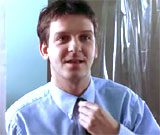 Alice's Live-In Boyfriend Jake (Jason Hughes) 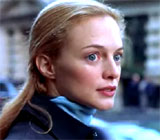 Alice Loudon (Heather Graham) 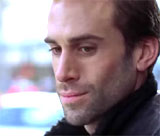 First Glimpse of Adam Tallis (Joseph Fiennes) at Cross-Walk 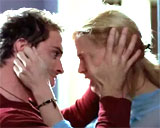 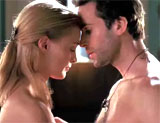 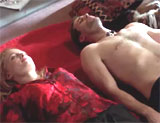 Fierce Passionate Love-Making 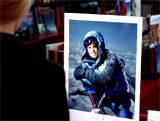 Famous Celebrity Mountain Climber Adam Tallis 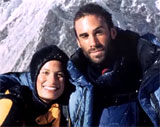 Picture of Adam with Dead Climber Girlfriend Francoise Collette 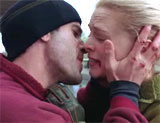 Adam to Alice: "Marry me!" 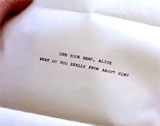 Mysterious Warning Letter 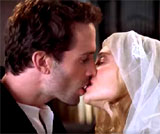 Wedding Kiss 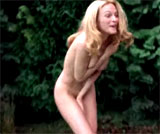 Post-Wedding Pics in the Cemetery 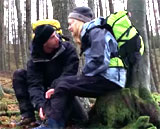 Hiking on Their Honeymoon to a Cabin 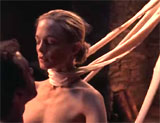 In Cabin - Adam's Fetish for Silk Scarf Asphyxiation 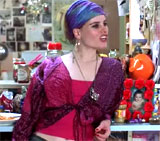 Adam's Alleged Rape Victim Michelle Stowe (Rebecca Palmer) from 1989 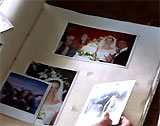 Adele's Incriminating Scrapbook With A Similar Polaroid Picture Taken of Her in Graveyard by Adam 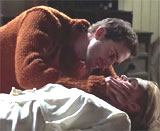 Alice Threateningly Tied Up on the Kitchen Table by Adam 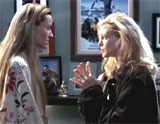 Alice Expressing Her Concerns to Deborah About Adam 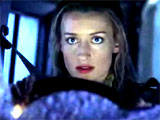 Deborah's Confession to Alice: "I sent you those notes" 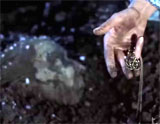 Adele's Body Unearthed, With Telltale Necklace 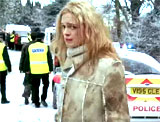 Alice: "And That's How It Ended" |
||||||||||||||||||||||||||||
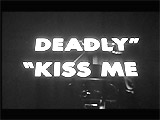
|
This late film noir was based on a Mickey Spillane novel of the same name. This independent film featured cheap and sleazy, contemptible, fascistic private investigator/vigilante Mike Hammer (Ralph Meeker) whose trademarks were brutish violence, the end-justifies-the-means philosophy and speed. The tough, ruthless cop's selfish, solitary pursuit of the white-hot object in a mysterious 'Pandora's box' led to nuclear catastrophe and annihilation during the explosive ending at a Malibu beach cottage - although there was no explicit mention of the words bomb, atomic, or thermo-nuclear in the nihilistic film. In the famous apocalyptic ending, waif-like femme fatale Lily/Gabrielle Carver (Gaby Rodgers) opened the film's doomsday McGuffin -- the "Great Whatsit" -- a leather-strapped, metal-lined Pandora's Box stolen from a government science lab. It was filled with nuclear material (loosely identified with "Manhattan project. Los Alamos. Trinity"). In a blinding white-hot light, she was incinerated and the beach-house she was in burst into flames with a powerful nuclear explosion. Whether detective Mike Hammer and his assistant Velda (Maxine Cooper) survived or not was not entirely clear when the film abruptly ended. In the film's restored version, they staggered onto the beach after escaping from the burning house and hugged each other in the surf. |
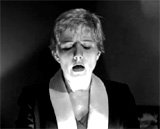 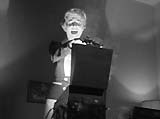 Lily (Gaby Rodgers) Opening the "Great Whatsit" Box 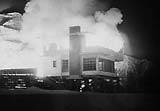 The Beach-House Explosion 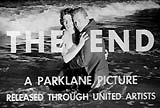
|
||||||||||||||||||||||||||||
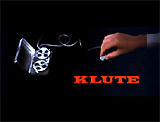
|
Klute (1971)
This suspenseful thriller and character study told about a New York City call-girl and aspiring actress named Bree Daniel(s), played by Best Actress-winning Jane Fonda. [Confusingly, Klute was the name of the small-town Pennsylvania police officer, not the name of the main female character.] The cynical and troubled Bree was suspected of being involved after the six-month disappearance of a Tuscarora, Pennsylvania company executive Tom Gruneman (Robert Milli). An obscene letter addressed to her was found in Gruneman's office - meaning that Gruneman could have been one of Bree's abusive clients (or johns). The Pennsylvania research firm's top executive was Peter Cable (Charles Cioffi), who (with Gruneman's wife) hired family friend John Klute (Donald Sutherland) to investigate the missing persons case involving his colleague. The 'homicidal' killer was suspected of sending obscene letters (Bree had received six or seven similar obscene letters "written by a very disturbed man"), making anonymous phone calls, stalking and abusing prostitutes, and was possibly involved in the suicidal deaths of two prostitutes (the second corpse belonged to Arlyn Page (Dorothy Tristan)). Although Bree admitted to receiving letters (and calls), she could not recognize or remember Gruneman when shown a photograph. In a tense concluding scene, Cable played an audiotape for Bree of his murder of the second prostitute, Arlyn Page. He was heard calmly promising the hooker: "Why don't you lie down on the bed and make yourself comfortable...Nothing's going to happen...Just put your head down. You have such lovely long blonde hair. Turn your head." Then, screams were heard as he strangled and killed her. Bree bowed her head, and silently cried. He had clearly admitted that he was the abusive client of the two dead prostitutes - both of whom he had killed to cover his own tracks. Cable had then framed Gruneman (who was also probably killed). By comparing typewriters, the obscene letters were traced to Cable.
After playing the tape and turning off the recording, the sick, psychopathic killer, suddenly attacked Bree. In the suspenseful ending, Bree was saved by Klute from a lethal attack by Cable. Having been found out, Cable (seen only in silhouette) appeared to jump suicidally from the building to his death (or he might have been thrown from the window by Klute?). The film concluded with Bree moving out of her NYC apartment and returning to Pennsylvania with Klute, with whom she had become romantically involved. She expressed fears to her therapist (in voice-over), however, that settled domestic life with him in Tuscarora, with a man so different than she was, might not work:
She also received a phone call from her female therapist, and further explained: "Well, I'm leaving town right now and I don't expect to be back..." The film ended as she left her empty apartment, with her continued voice-over to her therapist, casting doubt on her future life with Klute as a couple:
|
  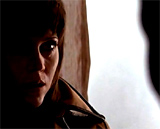 Bree (Jane Fonda) Listening to Cable's Audiotape of the Killing of Prostitute Arlyn Page 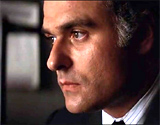 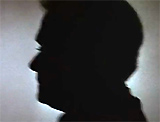 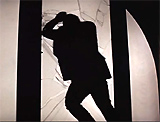 Sudden Attack on Bree, and Death of Peter Cable (Charles Cioffi) 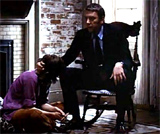 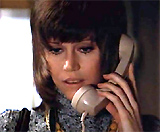 Final Scene in Bree's Empty NYC Apartment with Klute, Speaking to Her Therapist on Phone |
||||||||||||||||||||||||||||
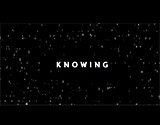
|
Knowing (2009)
Alex Proyas' sci-fi action disaster thriller was set up with the opening of a 50 year-old elementary school time capsule with letters written by Lexington, Massachusetts schoolchildren in 1959. The letter of sad, slightly disturbed schoolgirl Lucinda Embry (Lara Robinson) was selected by one of the school children:
The piece of paper had seemingly random numbers scrawled on it, and although Koestler believed in the randomness of the universe, he deciphered the numbers as meaningful and logical. He believed that a series of numbers in the letter, such as 911012996, referred, like Nostradamus, to "every major global disaster for the last 50 years in perfect sequence":
He then figured out that the numbers were in exact sequence by date, body count (2,996 died on 9/11), and then GPS positional coordinates (latitude and longitude). The recent death of his wife Allison by smoke inhalation in a Phoenix hotel room while on a business trip was included on the list - an additional hint that his own son Caleb had been chosen by Lucinda to receive the prophecies. In fact, Caleb was met a few times by silent, bleached-blonde, Nordic individuals in dark coats, "whisper people" (who also spoke to Lucinda through telepathy). They handed him a smooth black rock (a sign of the aliens' presence whenever seen in the film) - and he was allowed to envision a future event as a dream: a woodland wildfire consuming stampeding deer and moose. There were three more deadly events about to happen in the near future, and John was an eye-witness to each of them, the first of which was a realistically-fiery commercial plane crash near Boston's Logan Airport as John was driving on a clogged freeway. 81 died, due to an increase in electromagnetic radiation that fouled controls - according to reports. He also foretold a Worth and Lafayette St. (Manhattan) subway train derailment crash-collision that he again participated in. During his inquiries, Koestler met up with Lucinda's daughter, a single mother named Diana Wayland (Rose Byrne) who had a daughter named Abby (also Lara Robinson). Caleb and young Abby instantly became friends, although Diane at first rebuffed Koestler, but then met up with him again and admitted that her mother Lucinda had always warned her that she would die on October 19th (the last listed event). Together, they drove to Lucinda's abandoned mobile home trailer in the woods where her mother had died of a drug overdose (in 1988), and guessed (and found evidence) that the final numbers: 10190933 were actually EE="everyone else" written backwards, signifying that there would be no survivors in the final catastrophe on October 19, 2009.
Outside the mobile home in the film's ending, John was told by his son and Abby (who was also experiencing whispers) that the mysterious black-suited figures who had been following both of them thoughout the film ("the whisper people") had been trying to protect Caleb and Abby, and that the two children had been chosen to leave Earth (each with a rabbit) to start over on another planet, but Caleb's father was told that he could not join them because he couldn't hear their whispers:
The "whisper people" were revealed as four luminescent creatures with wing-like wisps of light emanating from them. After a heartfelt goodbye with his son, and the aliens' departure in a massive spaceship shaped like Ezekiel's Wheel (from a Biblical drawing of Ezekiel's "chariot vision"), Koestler traveled back to New York City to reunite with his estranged religious father Reverend Koestler (Alan Hopgood), and with his mother and sister Grace (Nadia Townsend), before the solar flare incinerated all life on the planet. A view from space showed that more than one spaceship took off from Earth. The last event was cataclysmic and apocalyptic - a disaster of worldwide proportions due to a massive, unstoppable solar flare (energy bursts that destroyed the Earth's ozone layer) that consumed the NYC skyline and Times Square (and soon the entire Earth), prefaced by chaos in the city's streets. The final shot of the film was of the two Boston surburban kids, Caleb and Abby, in pure white robes, running through a field of alien filament grass toward a beautiful, white crystalline tree - a tree of life in Eden? The reveal of the "whisper people" and the final scene on the alien planet (with spaceships landing) was controversial among viewers and critics for its religious implications, and the fact that the movie never clearly stated whether or not the "whisper people" were meant to be aliens, celestial angels, or some representation of both. These questions and confusions probably contributed to the film's cool reception. |
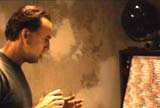 John Koestler (Nicolas Cage) 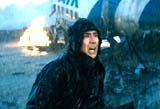 Plane Crash 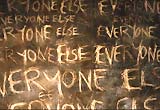 "Everyone Else" 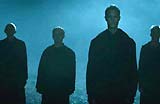 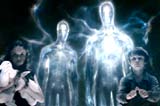 "Whisper People" 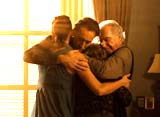 Koestler Reunited With Family Before Solar Flare  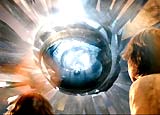 
Abby and Caleb Chosen to Leave Earth - and in Eden? |
||||||||||||||||||||||||||||